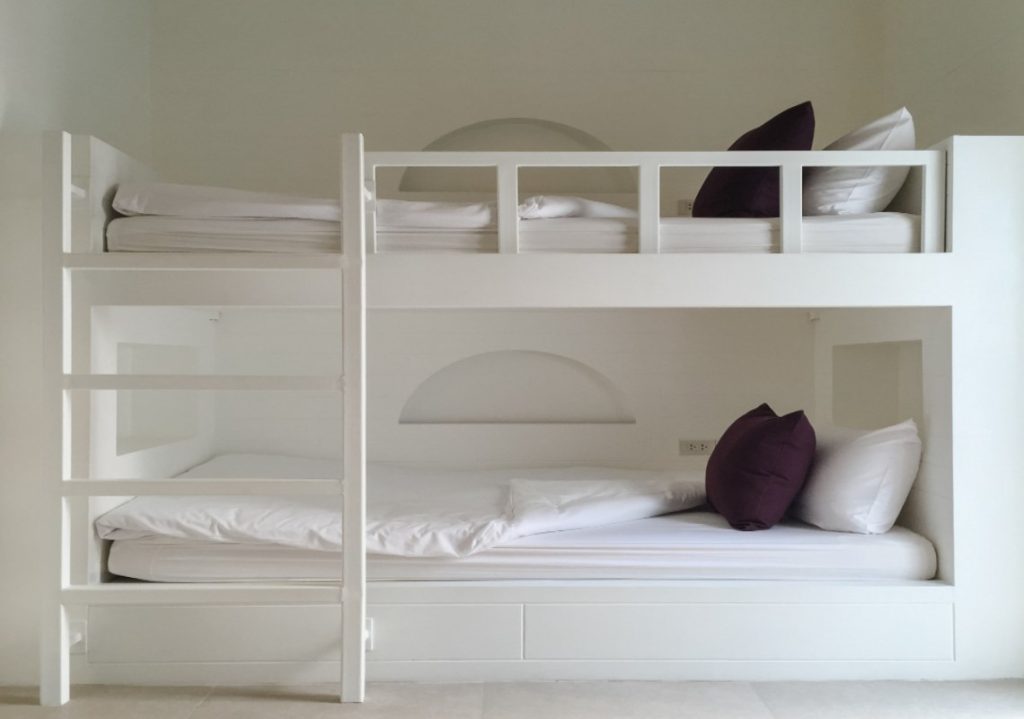
Finding the perfect twin bed and frame for your child can feel like a big task, but it doesn’t have to be overwhelming. Whether you’re transitioning your little one from a crib or simply upgrading their current setup, selecting the right bed is crucial for both their comfort and your peace of mind. After all, it’s not just about picking something that fits in the room — it’s about choosing a bed that will support their growing body, match their personality, and stand up to the wear and tear of childhood.
Key Takeaways
- A twin bed measures 38” x 75”, making it ideal for kids and small spaces.
- There are different twin bed frames, including platform, bunk, loft, and trundle beds, each with unique benefits.
- Safety features like sturdy construction, guardrails, and non-toxic materials are essential for kids’ beds.
- Transitioning from a crib to a twin bed is easier when done at the right time with a familiar bedtime routine.
In this guide, we’ll break down everything you need to consider when choosing a twin bed and frame for kids. From safety features and durability to style preferences and mattress options, we’ve got you covered.
The Standard Dimensions of a Twin Bed
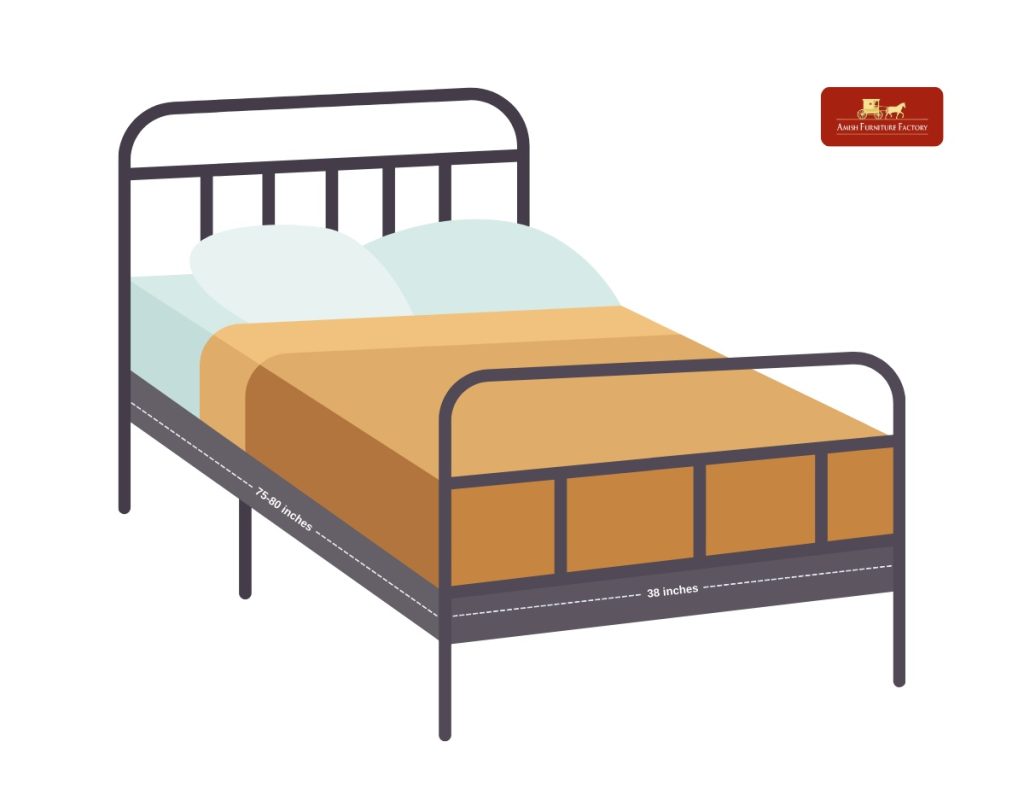
A standard twin bed measures 38 inches wide by 75 inches long. It’s typically the perfect size for a growing child. However, you’ll want to make sure that the room can accommodate a twin bed comfortably, with enough space to move around.
While a standard twin works for many children, some may need a little more space as they grow. If your child is tall or you expect them to be soon, a twin XL bed (38 inches wide by 80 inches long) might be a better fit. Similarly, a full-sized bed (54 inches wide by 75 inches long) offers even more room to spread out and may be a good option if your child is getting older and needs more space for comfort.
Why Choose a Twin Bed for Kids?
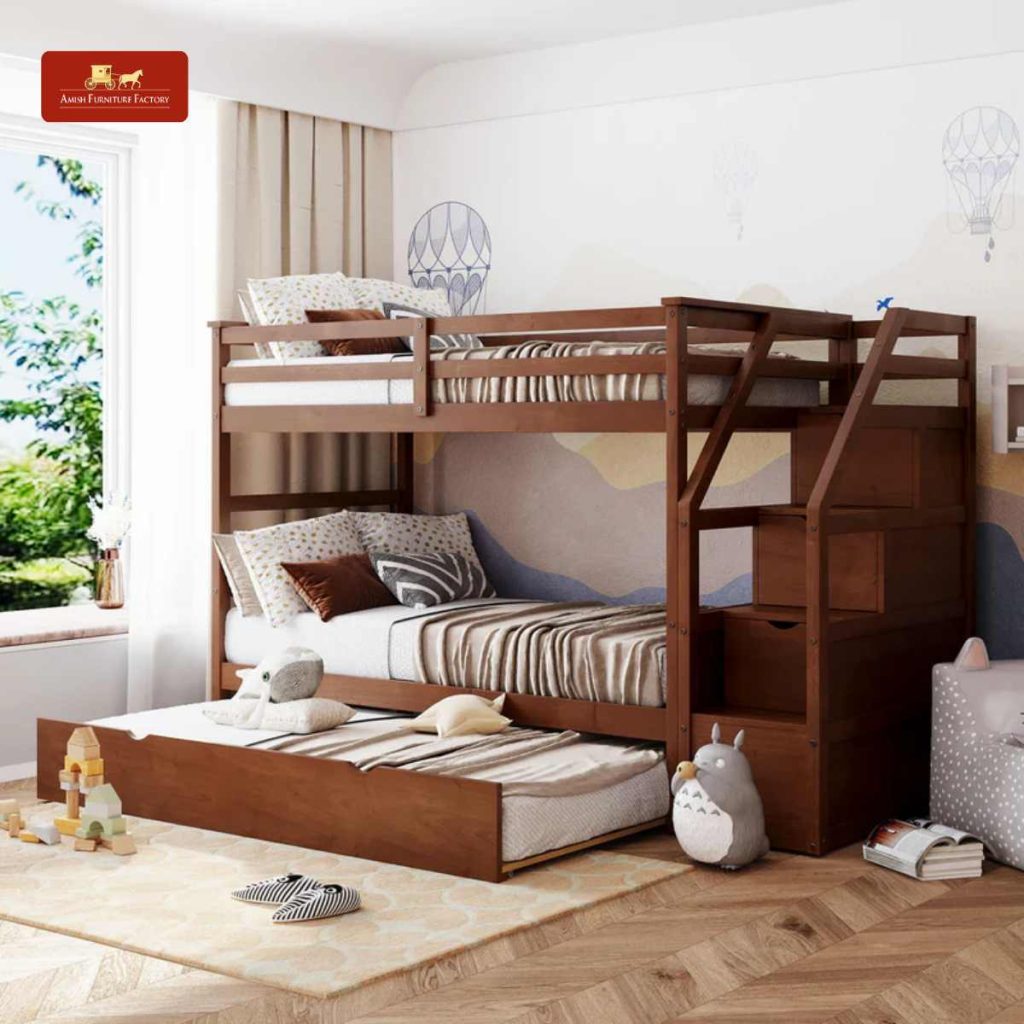
A twin bed is an excellent choice for kids, offering a practical solution for small spaces and growing children. Its compact size is perfect for small bedrooms, shared rooms, or multi-purpose spaces, allowing plenty of room for play, study, or additional furniture like a desk or storage unit. If you have two kids sharing a room, twin-sized bunk beds are a great option to maximize floor space without making the room feel cramped. Even in a small apartment or home, a twin bed provides a cozy, functional sleeping area without overwhelming the room.
In addition to saving space, twin beds are highly versatile and cost-effective. They suit children of all ages, from toddlers to teens, making them a long-term investment that adapts to your child’s changing needs. Many twin frames come with built-in storage or convertible features, adding extra practicality. Plus, twin beds are more affordable than larger sizes, with lower costs for the bed frame, mattress, and accessories like bedding and mattress protectors, helping families save money in the long run while still ensuring comfort and durability.
Types of Twin Bed Frames
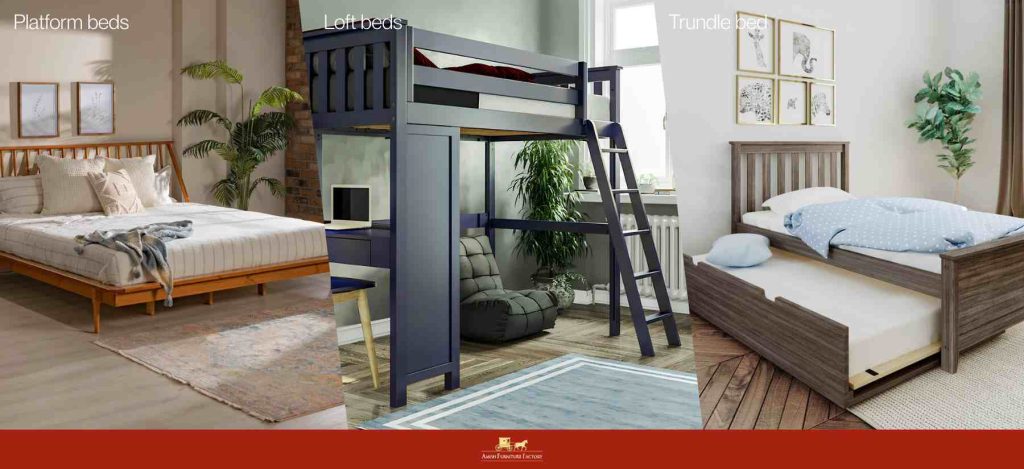
Twin beds come in a variety of styles, each offering different benefits depending on your child’s needs and available space. Some designs focus on maximizing floor space, while others include extra features like storage or additional sleeping areas.
Platform beds are a simple and sturdy option, sitting lower to the ground for easy access—great for younger kids transitioning from a crib. Many come with built-in storage drawers, helping to keep bedrooms organized. For siblings sharing a room, bunk beds are a space-saving solution that stacks two twin beds on top of each other. Safety features like guardrails and a secure ladder are essential, and some models can be separated into two individual beds if needed.
If space is limited, loft beds offer an elevated sleeping area with open space underneath, perfect for adding a study desk or play area. These are best for older kids who can safely climb up and down. Another option is a trundle bed, which includes a second pull-out mattress tucked underneath. It’s a practical choice for sleepovers or shared rooms and can sometimes double as extra storage when the lower mattress is replaced with drawers.
Material and Construction: What’s Best for Kids?
The material of a twin bed frame affects its durability, weight capacity, and overall aesthetic. Wooden frames are a classic choice, known for their strength and long lifespan. Solid wood options like oak, maple, or pine can handle daily wear and tear while offering a timeless look that blends with any decor.
For a lightweight and budget-friendly alternative, metal frames provide a sleek, modern design. While sturdy, they may creak over time and require occasional bolt tightening to maintain stability. Upholstered frames, covered in fabric or faux leather, add a soft and cozy feel to a child’s room. However, lighter-colored fabrics may require extra maintenance to keep them looking fresh.
For an eco-friendly option, bamboo frames are a great alternative. They are naturally durable, moisture-resistant, and often finished with low-VOC coatings to reduce chemical exposure. Parents looking for a non-toxic sleeping environment may also consider beds made with sustainable materials and formaldehyde-free finishes.
Here’s a comparison of the different materials used in twin beds and frames for kids to guide you in choosing the best one:
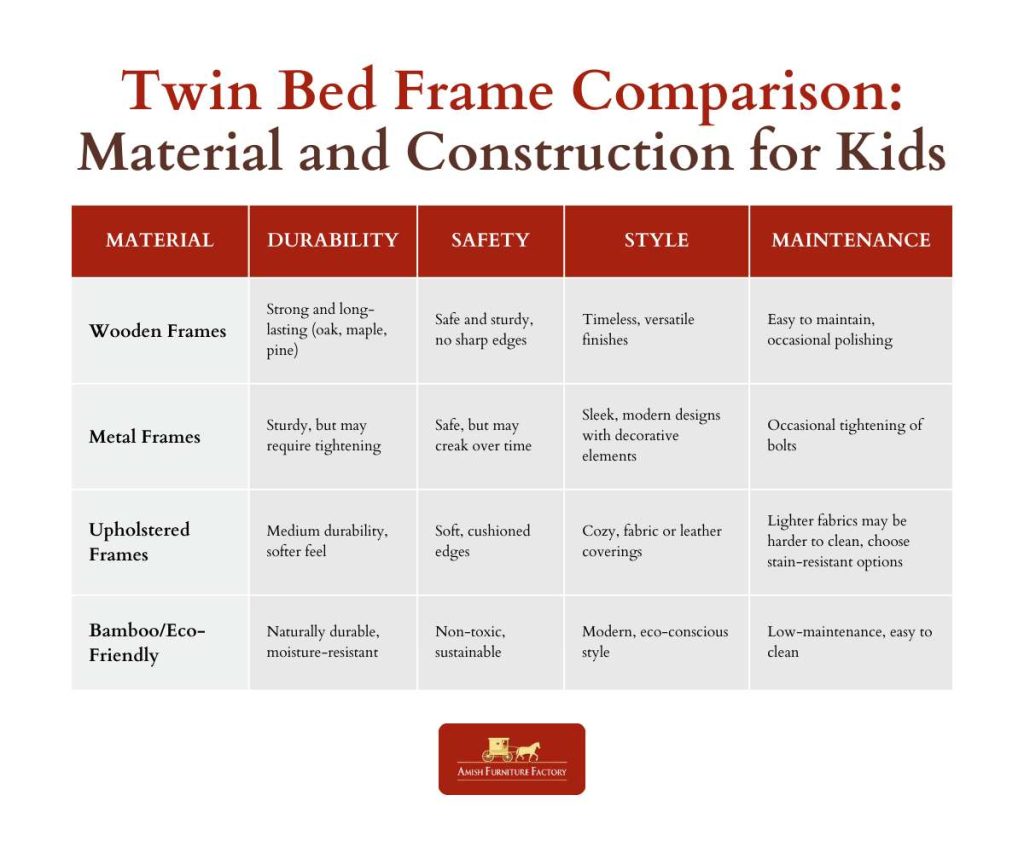
Safety Considerations
When choosing a twin bed for your child, safety should be just as important as style or size. A sturdy bed frame plays a key role in preventing accidents, providing better stability, and ensuring long-term use. Frames made from solid wood or reinforced metal offer more durability, especially for active kids. Make sure to check for secure joints and a high weight capacity to avoid any wobbling or shifting that could lead to accidents.
Features like guardrails are essential for elevated beds, such as bunk or loft beds, to prevent falls during sleep. These should be at least five inches above the mattress and securely attached to the frame. A ladder with non-slip steps also adds extra safety. Non-toxic materials like low-VOC finishes and formaldehyde-free wood ensure a healthier sleep environment. Additionally, a low-profile bed is a great choice for younger children as it sits closer to the ground, making it easier to get in and out and reducing the risk of falls during restless nights.
Styles to Match Your Child’s Room
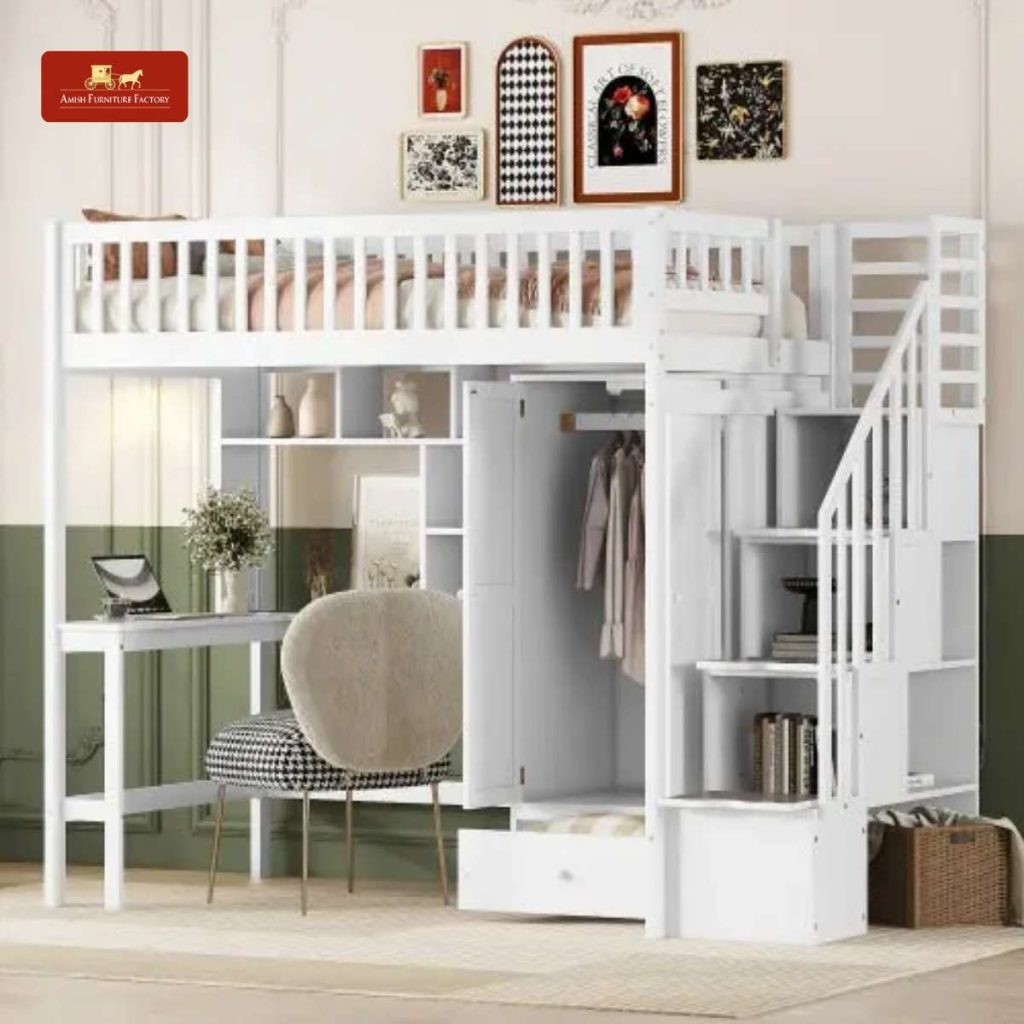
Kids love fun themes, and a bed that fits into their world of imagination can make bedtime more exciting. Whether it’s a race car bed, a princess canopy bed, or something based on their favorite character, a themed bed can really add a personal touch. That said, themed beds can quickly outgrow your child’s interests. If you want something that will last through various phases, consider opting for a versatile, neutral design—like a simple wooden bed with clean lines—that can be easily updated with different bedding or accessories as your child’s tastes evolve.
Another important factor is color. While a bright, bold color may be perfect now, it’s worth considering a bed that can transition as your child grows. Neutral tones like gray, white, or natural wood are great choices because they pair well with a variety of decor and won’t feel out of place as your child moves from toddler to teen. You can always change up the room’s accessories, bedding, and wall colors to reflect their current style.
Storage Solutions
A twin bed with built-in storage can help keep a child’s room organized while maximizing space. Whether you need extra room for clothes, toys, or books, there are plenty of smart storage options to consider. Here are a few ways to make the most of a twin bed’s design:
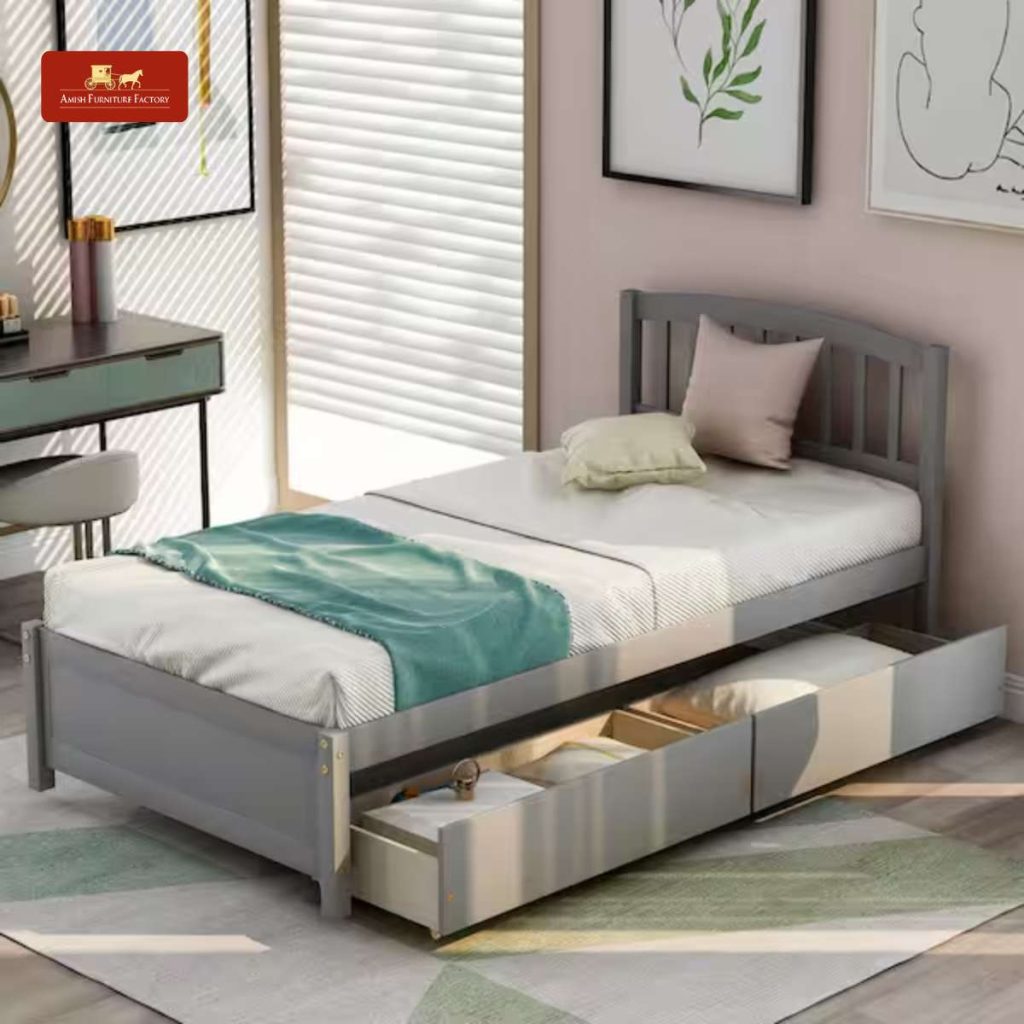
Under-Bed Drawers
Beds with built-in drawers provide a simple way to store clothes, blankets, or seasonal items without taking up extra space. Some designs come with deep, pull-out compartments, making it easy for kids to access their belongings. If the bed doesn’t have built-in drawers, rolling storage bins can be a great alternative.
Shelving Units
Some twin beds include shelves built into the headboard or frame, offering a spot for books, toys, or bedtime essentials. This is a great way to keep frequently used items within reach while reducing clutter. Open shelving also makes it easier for kids to organize their belongings.
Multi-Functional Beds
A multi-functional twin bed combines storage with other features like desks, seating, or lofted sleeping areas. These designs are perfect for small bedrooms where every inch of space matters. Some options even include built-in study areas, making them ideal for growing kids.
Budget Considerations
When buying a twin bed, it’s important to find a balance between affordability and quality. While some beds may seem like a good deal with a lower price tag, they often use cheaper materials that wear out quickly. Setting a realistic budget can help narrow your options and avoid overspending, but it’s also worth considering long-term value. The cost of a twin bed typically ranges from $50 to $300 for the frame, depending on the materials and design. Twin mattresses usually fall between $100 and $1,000, with prices varying based on quality and features. Keep in mind that spending a little more on a sturdy, durable bed can provide better long-term value.
Find a high-quality, durable twin bed for your child with handcrafted Amish beds built to last. Explore a variety of styles and finishes here to create the perfect sleep space.
When to Transition to a Twin Bed
Most children move to a twin bed between 2 and 4 years old, but the right timing depends on their growth and sleep habits. If your child is climbing out of the crib, resisting sleep, or waking up frequently due to limited space, it may be time to make the switch. Experts also suggest looking for behavioral cues, such as showing interest in bigger beds or wanting more independence at bedtime. While some kids adjust easily, others may need reassurance, so making the transition at the right time can help prevent sleep disruptions.
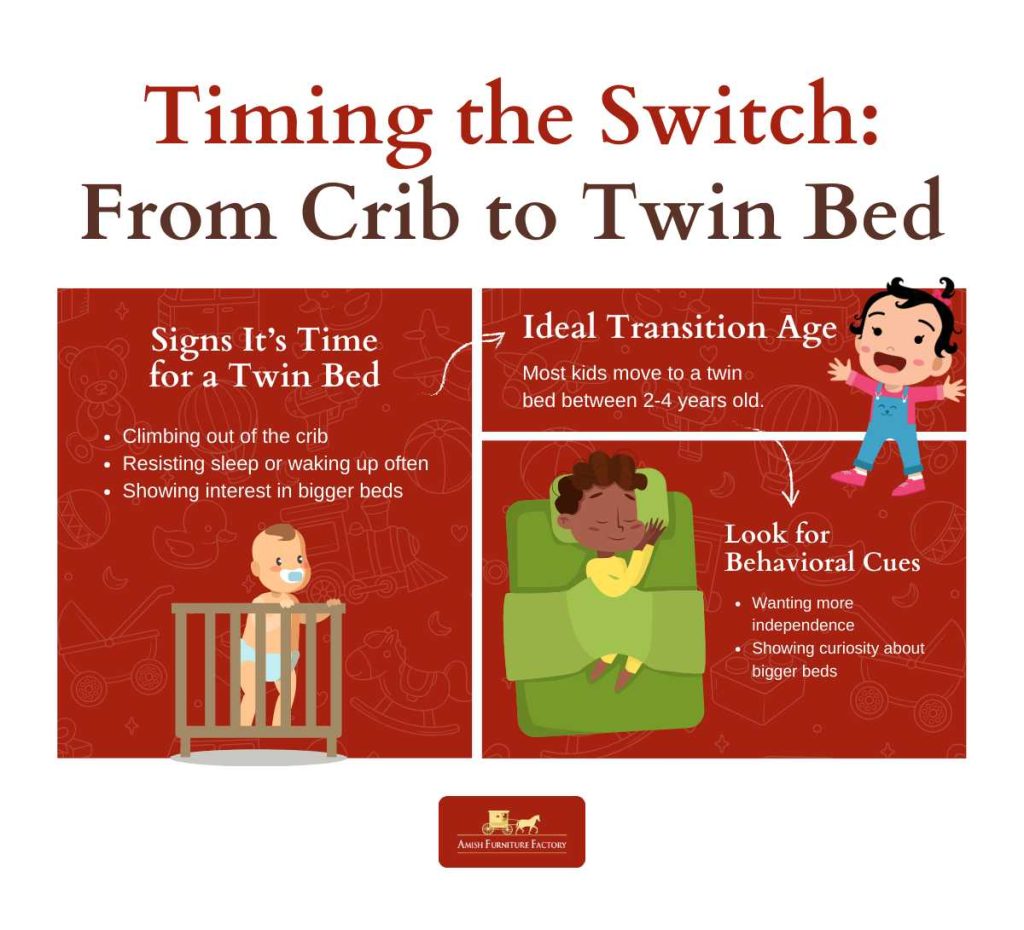
Conclusion: The Right Twin Bed Makes All the Difference
Choosing the perfect twin bed isn’t just about size—it’s about comfort, safety, and a design that fits your child’s needs. From sturdy frames and smart storage to fun styles that spark imagination, the right bed can grow with them for years. Prioritizing durable materials and space-saving options ensures a smart investment. Whether you need a simple platform bed or a multifunctional design, there’s an option for every family.
FAQs
What age is appropriate for a child to move to a twin bed?
Most children move to a twin bed between 2 and 4 years old, depending on their growth and comfort level. If they’re climbing out of the crib or seem too cramped, it’s a good time to upgrade. Some parents also make the switch earlier if they need the crib for a younger sibling.
How much weight can a typical twin bed frame support?
A standard twin bed frame can hold between 250 to 400 pounds, depending on the material and construction. Wooden frames and reinforced metal options generally offer higher weight capacity. Always check manufacturer guidelines for specific weight limits.
Are there twin beds suitable for small bedrooms?
Yes, many twin beds are designed to maximize space in small rooms. Bunk beds, loft beds, and trundle beds offer built-in storage or dual-purpose features. Platform beds with under-bed drawers are also great for compact spaces.
Can I use a twin bed frame with a memory foam mattress?
Yes, but make sure the bed frame provides proper support for a memory foam mattress. A slatted frame with close-set slats or a solid platform base works best. Avoid widely spaced slats, as they can cause the mattress to sag over time.
What are the benefits of a trundle bed for kids?
A trundle bed is great for sleepovers, shared rooms, or extra storage. It provides a second sleeping space that tucks away neatly when not in use. Some designs come with storage drawers instead of a mattress, adding extra functionality.
